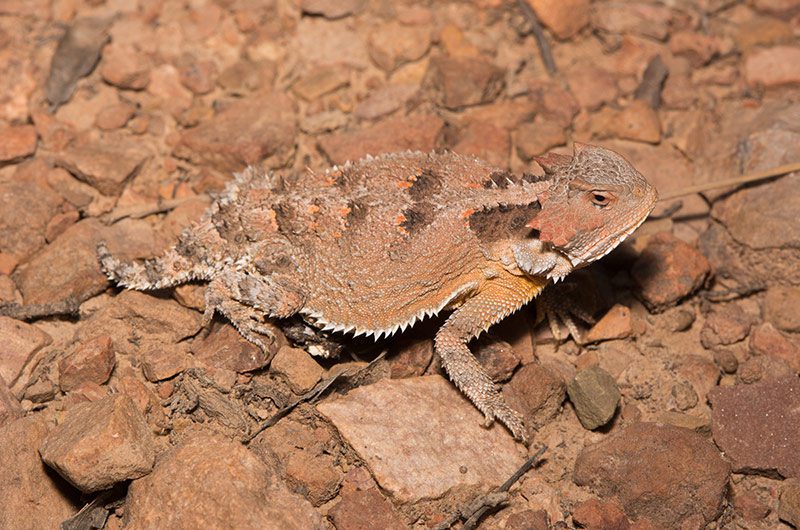LandPKS Learning
Habitat Hub

Greater Short-Horned Lizard
Greater short-horns are the only lizard species found in Alberta and Saskatchewan, Canada.
Phrynosoma hernandesi
Identification
Greater short-horned lizard is a relatively small lizard (about 6 in/15 cm), with a broad, round, and flattened body with a short tail, less than 1/3 the body length. Adult females are larger than males. The back is spiny, with a single row of spines fringing each side of their body. They also have spines at the back of the head that are as wide as they are long. The coloration and patterning vary across its range. They are generally gray or brown with small flecks of white or orange with several larger dark spots on the back. Greater short-horned lizards tend to be the color of the soil blending cryptically. The greater short-horned lizard is considered Endangered in Canada.
Observation Tips
Greater short-horned lizards are found in Alberta and Saskatchewan, south through the western United States and into Mexico. They are the most widespread of all horned lizards. Lizards are active during warmer daylight hours and at surprisingly low temperatures in Canada. They hibernate in shallow burrows, which can lead to winter mortality in northern populations. Greater short-horned lizards give birth to 5-36 young in July through September. Young as small as 0.9-1 in/2.3-2.4 cm in length.
Interesting Fact
Greater short-horns are the only lizard species found in Alberta and Saskatchewan, Canada.
Ideal Habitat
Greater short-horned lizards inhabit semiarid grasslands, shortgrass, and mixed grass prairie, sagebrush shrublands, outcrops, and openly wooded areas with sparse vegetation at ground level. Soils vary from rocky to sandy, preferring loose soils. In Canada, they prefer south-facing slopes. These lizards burrow in the soil as well as occupy rodent burrows. Greater short-horned lizards eat ants, beetles, crickets, other insects, spiders, and snails. Too much vegetation (>40% herbaceous) may deter the lizard from moving through the landscape. They prefer areas with 40-65% bare ground.

Range map provided by International Union for Conservation of Nature
Management Activities that Benefit Species – Best Management Practices (BMPs)
Maintain intact grasslands, shrublands, and other natural rangeland habitats. Weed control should take an integrated approach. Livestock grazing is compatible with greater short-horned lizard as this species prefers open grasslands and sparse vegetation. Watch out for greater short-horned lizards when driving as these lizards remain motionless when threatened, therefore, are easily killed by cars.
Management Activities to Avoid
Avoid converting native grasslands and shrublands to cropland, oil and gas, and residential development. Avoid off-road vehicle use. Avoid collecting or letting others collect greater short-horned lizards. As the lizards feed on insects, avoid use of pesticide and insecticide on rangelands.
Other Species that Benefit from Similar Habitat Management
Management for greater short-horned lizard will benefit western rattlesnakes, striped whipsnake, loggerhead shrikes, rattlesnakes, and burrowing owls that prey on greater short-horned lizards.
Download
Download the Greater Short-Horned Lizard factsheet
Other Resources
Canada COSEWIC 2007 Assessment and Update Status Report on the Greater short-horned lizard in Canada
International Union for Conservation of Nature (IUCN). 2014. The IUCN Red List of Threatened Species. Version 2021-1 Greater short-horned lizard
Montana Field Guide Greater short-horned lizard
NatureServe. 2021. NatureServe Explorer: An online encyclopedia of life [web application]. Version 7.1. NatureServe, Arlington, Virginia. Phrynosoma hernandesi
South Dakota. Amphibians and Reptiles of South Dakota. Greater short-horned lizard
Photo credit: Andrew DuBois/Flickr
Mobile App | Data Portal | Knowledge Hub | Habitat Hub | Learning Collections | Blog | About | Contact | Support



